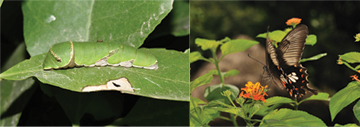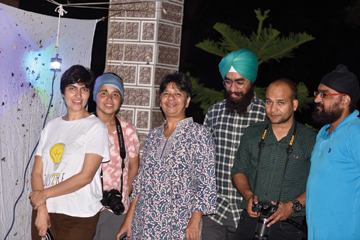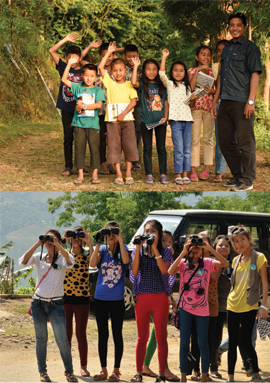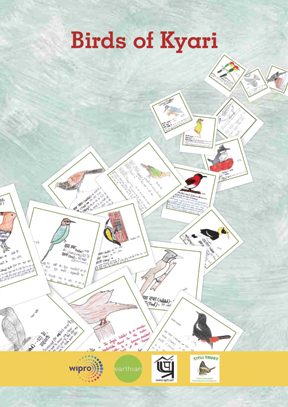Sanjay Sondhi
Citizen science is defined as, “The collection and analysis of data relating to the natural world by members of the general public, typically as part of a collaborative project with professional scientists.” (Oxford) To me, citizen science means something different. I use citizen science as a tool to get people – children and adults – interested in nature, so that they can participate in a global movement to protect our natural world. Whatever tools I can use to get people to appreciate nature works for me. Citizen science is one such tool that I can use, especially with the largely tech-savvy urban and rural youth of today.
Learning to appreciate nature
Unlike many nature educators, I do not use formal and structured educational tools to create the initial interest. Natural history and conservation storytelling combined with experiential learning is what really works to create the initial curiosity, especially among children. Nature walks are a great way to start this journey. My firm belief is that the very first step in nature conservation of any kind is a love for and an appreciation of nature. Recently, during a wildlife week program in an urban school, in the heart of Dehradun, I was invited to conduct an awareness session with the school children. On reaching the school campus, I was dismayed to find that a concrete jungle surrounded the school building. How in the world could I take these kids out for a nature walk? I asked the teacher for five minutes, during which I walked around the small school ground. In this short duration, I found the caterpillar of the Common Mormon butterfly on a lime plant, the cocoon of the Green Coat moth on a mango tree and an Argiope signature spider on a small tree. I took the children in small groups to show my discoveries and they were pleasantly surprised (and hooked) to see that even their small school campus had so much to reveal. As we were walking around the school ground, a Common Mormon butterfly even whizzed by the children, making the experience even more satisfying.

In 2014 we started a citizen’s movement in Dehradun called Doon Nature Walks (http://www.titlitrust.org/Doon_Nature_Walks.html). The primary aim of Doon Nature Walks is to create an appreciation of nature among the residents of Dehradoon, contribute to citizen science, create awareness and outreach activities to support nature and its conservation. Today, the group has more than 1,200 Facebook members and 200 WhatsApp members and they are actively involved in photographing and documenting birds, butterflies and moths, as part of citizen monitoring programs in Dehradun. Citizens have undertaken a moth-monitoring project at four sites in Dehradun for the last five years. This citizens group has unearthed many interesting bird records in and around Dehradun. School children, adults, researchers and scientists participate in these activities.
For teachers, getting their students to start a citizen science project can be a fulfilling and rewarding experience that can continue across numerous batches of students and make a meaningful contribution to nature conservation.
How can I initiate a citizen science program with my students?

Form a group: Getting interested students involved in this activity is essential. Form a nature club or an ecoclub. Let the students name it and design a logo.
Giving the group a purpose: Discussions on why the club is being formed and the need for all of us to take ownership of our actions to protect the Earth and nature are a great starting point. A citizen science project can be the students’ contribution towards nature conservation.
Selecting the citizen science project: Let the children deliberate the citizen science project they want to take up. Many different platforms and apps exist, which the students can use to collect and analyze data meaningfully and also as tools for species identification.
Flora: Season Watch (https://www.seasonwatch.in)
Birds: (https://ebird.org/india/home)
Butterflies: (https://www.ifoundbutterflies.org)
Moths: (https://www.mothsofindia.org/home)
Marine life: (https://www.marinelifeofmumbai.in)
Shells: (http://www.biologyeducation.net/natural-history/molluscs/image-gallery/)
Nature in general: (https://www.inaturalist.org).

Purpose of the citizen science project: The students need to deliberate what the purpose of the project is, this will determine the project protocol, what data should be collected and how it gets collected and analyzed. For example, your project could simply be to monitor the species diversity and density of birds or butterflies on your institution campus for a year. Or monitor how these diversities and densities change over a five-year period. You will need to be able to identify the species and count them periodically. To participate in any citizen science project, one needs to have at least a rudimentary knowledge of the elements of the natural world that one intends to study. Getting an experienced citizen scientist or an NGO involved at the design stage is a good idea, as it will permit the students to discuss the project in detail before starting, as well as get support for identification, observation and the overall project design.
What tools do you need? The tools that the students need will change with the project. Some of the things that may be needed are mentioned below:
Flora: tree/flower identification guide book.
Birds: binoculars, bird identification guide book.
Butterflies: camera, butterfly identification guide book.
Moths: moth screen, moth light, camera, torch, moth identification guide book.
In all cases, access to a mobile phone or computer for recording the data is desirable.
Selecting the study site and the periodicity: The project you select can be done at different intervals (weekly/monthly), and the project site could be your institution campus or a green area or park near the school. If you select a moth project, then your observations will necessarily be at night, so you need to decide whether this is at all possible.
Data gathering: What data you will collect, how you collect it and finally how you will analyze it needs to be discussed. In any citizen science project, rigor, by adopting and following protocols, is necessary. So, the team needs to come together to decide what the protocols will be for data collection.

Publications: The students can compile and publish a field guide to the birds or butterflies of their campus, in the short term. In the long term, the students can look at monitoring the change in taxon over time. Ideally, if the project can be continued for a longer duration, with a new team of students taking the responsibility of continuing the project every year, some great data can be generated in the long term. In the village of Kyari, in Uttarakhand, the school children of the ecoclub documented the birds they saw in their village and painted these along with natural history stories. The booklet they made can be downloaded here https://drive.google.com/file/d/1KiTZ2Yrt8gzn9MxoeL63tqJLTUGvrOW0/view?usp=sharing.
How will a citizen science program benefit students? A citizen science project run by students will hopefully stimulate a love for nature among them. An appreciation of nature is likely to be a lifelong love affair. In today’s hectic world, being part of a larger project and purpose and making a contribution to help protect nature can be invigorating. The students will also learn how to design a project and run it, collect and analyze data and possibly publish it in a scientific or popular journal, which is rewarding in itself and has value irrespective of the careers students choose.
If you need help to design your own citizen science project, reach out to a local nature conservation NGO in your area or contact the author at his email address.
The author is a Dehradun-based naturalist. Studying natural history has been his passion for more than three decades. His interests also include photography and writing about nature. He has authored more than a dozen books and over 30 technical papers on amphibians and reptiles, birds, butterflies and moths and other Indian wildlife. He can be reached at sanjay.sondhi1@gmail.com.
